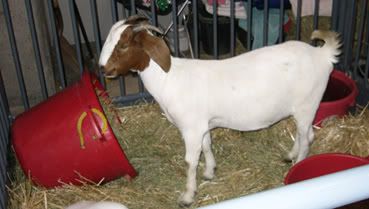Rohgen goat
The Rohgen is a breed of goat, named after the region in Mikitivity where the breed originated, the Rohgen valley in Brey and Thoris cantons. Rohgens are medium sized, moderate in production, and have a relatively low butterfat content in their milk. Today they are found throughout most of Mikitivity where they are farmed for their milk or used to aid in weed maintenance. The milk from Rohgen goats is also used to make several cheeses, including Hafenkase. They are very social, not aggressive, and easily domesticated, making them a popular breed in NationStates.
Contents
Appearance
</div>Rohgens are medium sized goats that are mostly white or grey with brown heads. Their coloring makes them harder to spot on mountain sides at night. Sometimes the goats will be all brown, due to a recessive gene, but other than the color variation, the goats are identical to other Rohgens. Like most goats, when healthy, their short tails curl upwards.
In some countries their horns are not removed, as the goats are herded on the sides of hills and mountain slopes, where they may need their horns to fend off predators. Though generally not aggressive, mothers will tend to head butt other adults that approach their young and their horns may wound other adults.
Does typically weigh around 150 lb (68 kg) and bucks weigh over 200 lbs (91 kg). Young reach adult sizes when they are about 1 year old, but their horns develop their second year.
Like most goats, Rohgen have a lower set of teeth which meet a hard pad in the upper jaw, and 24 molars on the top and bottom in the back of their mouths. They make extensive use of their molars for chewing grasses and other plants. Kids have fewer sharp teeth in their lower front jaw that are replaced by permanent teeth as they age. The age of a goat can often be closely determined by their teeth.
Habitat
Rohgens predate human settlement in the Thuvian and Solace mountains in Mikitivity, and Ursine settlement in the 'High Ranges' of Bears Armed, and prefer colder, rocky terrains. However they were quickly and easily domesticated when people moved into those mountains, and it has been suggested that they were actually feral descendants of a stock that had been domestic animals in the time of the now-extinct 'Luvasian' civilisation.
Native Environment
List of countries where Rohgens are a native species:
Non-Native Environment
Due to their calm nature, Rohgens are sometimes bred outside of their native habitat.
List of Countries where Rohgens are an introduced species:
- unknown
Diet and Predators
Rohgen are ruminants or cud chewing animals that eat hay, grasses, and weeds. The goats will also eat many seasonal wildflowers, including the Solace Chamomile. The Rohgen are adapted to the mineral soils in the Thuvian and other mountain ranges in the International Democratic Union, thus when herded in other areas, they frequently need vitamin supplements to maintain milk production and fur growth. Despite rumours that Rohgen will eat anything, the goats will never eat soiled grasses nor plants that will be dangerous to them. They feed day and night as needed, and once they have grazed a region will move on. They are careful to not overgraze a particular region and are important to the native grasses, as they carry grass seeds from mountain valley to mountain valley.
One of the greater dangers to Rohgens is exposure to the elements and risk of parasitic infection. Like many other goats, Rohgens are highly suspectible to diseases such as foot rot or black leg. The goats can catch these diesases through prolonged contact with containated soils. Penicillin and other anti-botics are extremely effective in fighting the infections and Rohgens whom are treated make immediate recoveries. Younger goats have strong immunities to these sorts of dieases.
Life Cycle
Rohgen goats have a seasonal breeding cycle that beings in the fall when the days begin to grow shorter. Bucks typically go into rut, a period when the male's appetite decreases and his sexual desire increases, a few weeks after the does begin to go into heat. Bucks that are in rut will be aggressive towards only other bucks in rut when a doe is near. When the buck finds a doe ready to reproduce, he'll mark her by urinating on her, thus negating her own sent and preventing other bucks from taking an interest in her. Competing bucks will head butt each other until either one tires or the doe leaves.
As with most goats, the gestitation period is approximately 150 days. Typically twins or triplets are born in a process known as kidding. The birth of more than 2 or 3 kids is extremely rare, with only the two stronger kids surviving the spring. Rohgen kids typically nurse for 6-7 months, which is a longer period than most goats.
Rohgens tend to live 9 to 12 years, having a slightly shorter lifespan than many other goat species, but there is a higher precentage of the goats that live out their full 12 year lifespan. There have been documented cases of a few Rohgen living to the age of 13.
Social and Economic Significance
When slaughtered, the intestines of the goats are cleaned and used as the lining for sausages. Although on rare occasions sausages are made from Rohgen goat, most sausages such as Brey Bratwurst do not make use of these diary goats for meat, but still will use their intestines.

